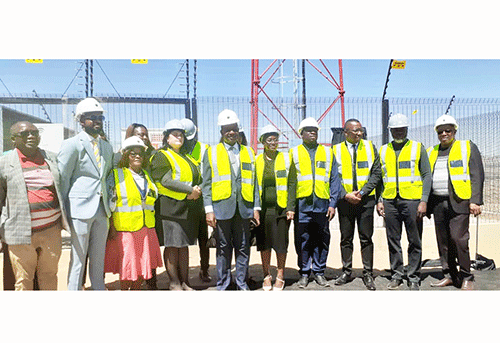Information and communication technology minister Peya Mushelenga said access to information technology (IT) services and facilities is no longer a luxury but a necessity, given the role these technologies play in society.
Mushelenga made these remarks yesterday at the launch of the newly constructed PowerCom Goreangab tower, which constitutes an investment of over N$965 000.
PowerCom is a wholly-owned subsidiary of Telecom Namibia and serves as an ICT infrastructure and equipment provider.
Since 2013, the company has predominantly focused on erecting towers to enable service providers and operators to lease space on the towers. Through this, the service providers offer network coverage and related services to their respective clients.
The ICT minister noted that his ministry is dedicated to establishing a legal framework that permits operators to offer IT services and strengthen the nation’s capability for digitalisation.
Mushelenga also commented on PowerCom’s use of its licence to serve the nation to maximise and offer the best services possible to the populace.
“Given the increasing role of ICT in daily lives of people, the regulator is compelled to ensure the provision of affordable communication solutions and protect consumers from excessive costs that are generally imposed by operators. Thus, the government closely follows the sector, monitoring customer satisfaction from quality, accessible and affordable services,” he assured.
He further stated that Namibia has made significant strides in enhancing online financial accessibility, promoting economic opportunities for women, and increasing patent applications among 131 nations.
While these achievements are commendable, Mushelenga admitted there is room for refinement in specific areas, such as mobile app development, e-commerce policies, mobile broadband internet traffic and income inequality.
Identifying these improvement areas is essential for propelling the country’s continued growth and development, he noted.
Mushelenga further noted that preparing for future business demands and trends can be challenging and rewarding when planning and executing effective strategies.
“The expansion of 5G coverage in 2023 will enable quicker communication and enhanced performance, leading to innovation and the emergence of new technological trends in fields such as automation and artificial intelligence,” the minister assured.
In choosing to construct a tower in Goreangab, PowerCom CEO Beatus Amadhila said the company was guided by its mission to ensure all Namibians have access to ICT infrastructure, irrespective of their economic status or location.
“We have very ambitious plans to build enough towers to meet the rising demand – but at the moment, this is the only tower we have in this area. However, we have applied for more sites within this area, pending municipality approval, upon which we intend to roll out additional infrastructure of this nature in areas such as Greenwell, Otjomuise, Hakahana and beyond,” he assured.
The CEO further stated the company completed 18 sites in the last financial year, worth N$21.6 million.
Meanwhile, current projects stand at N$7.2 million – and for the upcoming financial year, another investment of N$36 million has been set aside to construct an additional 30 sites.
At the same occasion, PowerCom board chairperson Eldorette Harmse said Windhoek is a city on the rise, and it is, therefore, experiencing significant growth.
“Our analysis shows that we need approximately 30 new sites in Windhoek to provide adequate services to the capital city. Currently, we have received approval from the City of Windhoek to build six new sites within the city limits, two of which are now under construction. We have identified four additional sites for construction in the upcoming financial year, pending the receipt of environmental clearance certificates,” said the chairlady.
Harmse continued that as far as Khomas region tower construction rollout plans are concerned, PowerCom is currently waiting for feedback from the city on 22 site applications, which, if approved, will significantly impact connectivity in the region.
“We estimate a requirement for at least 300 new sites within the next three to five years, the operationalisation of which will have a transformative impact. If we achieve this goal, the positive impact of having these towers operational will be significant,” she shared.
Furthermore, the Communications Regulatory Authority of Namibia (CRAN) last month stated that Namibia has observed a 6% increase in population coverage for 4G services during 2023.
Despite this positive trend, the Kunene region exhibited the lowest coverage at 41%, followed by the Omaheke region at 57% and the Kavango West region at 59%.
These figures indicate that these areas remain the least covered in terms of 4G services.
“This growth can be mainly attributed to the substantial investments in infrastructure made by operators in recent years. One notable example is the implementation of MTC’s 081-everyone project, which started in 2019,” reads CRAN’s first quarter statistics of 2023. – mndjavera@nepc.com.na


